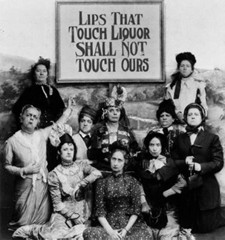 From the northernmost portion of Canada comes a salient lesson on mankind’s bottomless thirst for booze—a thirst that we’ll go to ridiculous lengths to slake:
From the northernmost portion of Canada comes a salient lesson on mankind’s bottomless thirst for booze—a thirst that we’ll go to ridiculous lengths to slake:
The announcement of an alcohol task force comes on the heels of a string of bootlegging busts across the territory. At a news conference Wednesday, RCMP Sgt. Jimmy Akavak said the police seized $400,000 worth of bootleg booze since January alone.
Bottles can command high prices, especially in dry communities, where a 60-ounce bottle of vodka can go for as much as $600, Akavak said.
As he spoke, Akavak stood next to a massive display of hundreds of bottles of alcohol, mostly vodka, that police seized in recent raids. Akavak said 80 to 90 per cent of the RCMP’s workload is related to alcohol.
To put that CN$600-per-bottle figure in perspective, you need to realize that the average per-capita income in Nunavut is approximately CN$11,000. That means the residents of the territory’s dry counties are willing to spend 5.5 percent of their annual income on a single bottle of Smirnoff vodka (the region’s most popular tipple, according to the Nunavut Liquor Commission).
Our stock solution here is to end prohibition—it would instantly eliminate the black market, and free up the Mounties to tackle other pressing issues. But we’re also sensitive to the terrible havoc that booze has wreaked on many Arctic communities over the years. Is there a middle-ground solution here?
Earlier on Microkhan: Is prohibition actually working in the Alaskan hinterlands?


Jordan // Apr 7, 2010 at 1:12 pm
If you haven’t checked it out, “Chasing the White Dog” is a really great book about illegal alcohol production in America. Definitely shows some of the lengths people will go to get drunk, especially in dry places like Philladelphia (which apparently consumes a vast percentage of the nation’s moonshine).
It’s definitely a tricky business prohibiting alcohol is that as long as you can get sugar and a bit of space, you can ferment and distill. And with the internet, there is a vast corpus of information to get you through the early optimization steps.
tsg // Apr 7, 2010 at 2:53 pm
The people of Nunavut and this NY Times tasting panel agree: Smirnoff is the good stuff.
http://www.nytimes.com/2005/01/26/dining/26wine.html?_r=1&scp=1&sq=smirnoff&st=cse
Brendan I. Koerner // Apr 7, 2010 at 8:18 pm
@Jordan: Many thanks for the rec. Hadn’t heard about that book, but love the description. Added to the to-read list. But I’ll first read the excerpt on the author’s site:
http://www.maxwatman.com/MaxWatman.com/Max_Watman.com.html
@tsg: I’ll confess, I totally don’t get the concept of vodka tasting. Isn’t the paragon of quality a total absence of taste? I mean, I understand why the cheap charcoal-filtered stuff is nasty. But I find it impossible to discern, say, Ketel One from Grey Goose. Maybe you just need a very special palette.
Jordan // Apr 7, 2010 at 10:58 pm
@Brendan
I got really lucky and was about to hear Max Watman give a talk at one of the local distilleries. We sampled a bunch of white dog whiskies while we were at it. Good times.
tsg // Apr 8, 2010 at 1:10 am
@Brendan: Exactly. Unlike other spirits, it seems to me vodka’s only important job is to taste clean, pure and and not too fiery, with only the gentlest of hints of actual flavors other than alcohol. Every expensive vodka I’ve tried more or less achieves this, but none does so markedly better than a $15 bottle of Smirnoff. It’s the best bang for your buck bottle of booze you can buy.
It saddens me to learn the people of Nunavut are paying so much for it, if they can get it all. As if living in the Arctic weren’t punishment enough.
scottstev // Apr 8, 2010 at 11:14 am
@tsg and @Brendan. Other than a good G & T (much harder to make than you would think), I realize now that I’m a brown liquor type of guy. Being the geeky contemplative sort, I can get lost in the differences between Cognac, Irish Whisky and Bourbon.
All dark liquors are basically the same at the final point of fermentation. It’s basically a clear flavorless liquid called L’Eau de Vie in France or Everclear in the US. The subtleties come out in the aging and the barrels.
Brendan I. Koerner // Apr 8, 2010 at 11:21 am
Ah, yes, the infamous Everclear. Immortalized by one Bushwick Bill:
http://www.youtube.com/watch?v=KLnbQZnBeCw
Jordan // Apr 8, 2010 at 2:00 pm
@scottsev
I’d have to disagree with your statement that all brown liquors are the same at the point of fermentation. Otherwise you could stick them all in the same type of barrel and come out with the same spirit. In addition, good spirits with complex flavor profiles are usually going to be produced in pot or alembic stills, which have lower separation between the heads, hearts and tails fractions, which means that the distillate will usually come off at a lower proof (without multiple distillations) and carry more of the flavoring compounds with it.
With that said, there are also differences between well-made white liquors. It’s just that the bulk of white liquors are targeted for smoothness and mixability, which means that the distillers intentionally strip out a lot of the flavoring compounds present in the mash, either through reflux distilling, repeated filtration through activated charcoal or some combination of the two. For instance, I’ve tried a variety of white dogs produced from different grains and the flavor profiles and noses of each spirit had unique characteristics.